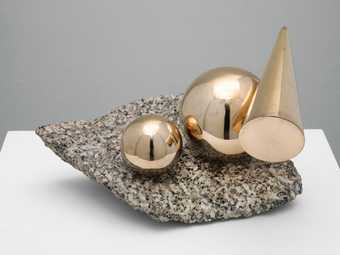
Marlow Moss, Balanced Forms in Gunmetal on Cornish Granite 1956–7. Tate. © reserved.
Modern Landscapes
6 rooms in Modern Conversations
Works in this room explore environments from Cornwall and across the world
How do you define a landscape? Beyond depicting scenes of nature, these works consider environments seen from above, below or within.
In the 20th century, manufacturing, technology and transport dramatically transformed how people lived and worked. Growing cities and industrialisation altered surroundings forever. Some artists responded with radical approaches that broke away from traditional painting and sculpture. The artists shown here were influenced by developments in fields such as science, politics and philosophy. They borrowed from these to investigate our environments and how we understand them. Their works question and reflect on our modern relationships with landscapes, sometimes going beyond what we can recognise or see. In this display, landscapes range from the vast to the invisible and also bring cultural and political perspectives.
Spotlight on Marlow Moss (1889-1958)
Art is as – Life – forever in the state of Becoming
Marlow Moss moved from Paris to Cornwall in 1941, fleeing the war in mainland Europe. A co-founder of the international group Abstraction-Création, Moss wanted to create art that would speak across cultures and capture the spirit of the time. Moss pioneered the graphic ‘double line’ motif, using systems of measurement and proportion to create a dynamic ‘rhythm in space’. Moss explained this in letters to the Dutch painter Piet Mondrian, who later used it in his work.
Moss’s abstract work and deliberately masculine appearance challenged both artistic and social conventions of the time. Moss’s approach to modern art and identity continues to provoke vital debate about art history, making, and gender.
Tate St Ives
Level 3
Ongoing
Entry to both the display and the gallery is free for Tate Members, Locals' Pass holders and under 18s.
Become a member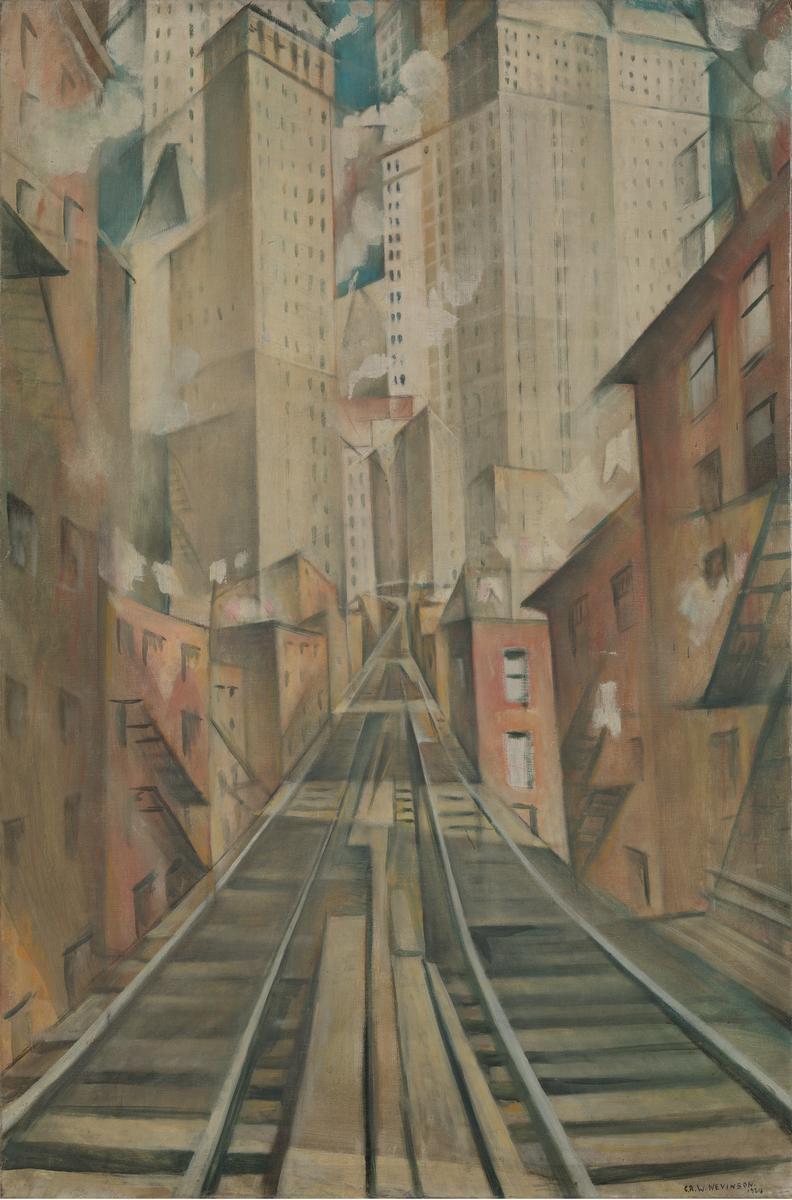
Christopher Richard Wynne Nevinson, The Soul of the Soulless City (‘New York - an Abstraction’) 1920
The skyscrapers and railways of New York epitomised the dynamism of the modern metropolis. This painting, originally titled ‘New York – an Abstraction’, shows the former-futurist Nevinson’s enthusiastic response, in which the urgency of the city is matched with a modernist style of painting derived from pre-war abstraction. However, Nevinson’s work did not receive the success for which he had hoped, and his initial excitement gave way to the disillusion indicated by his revised title.
Gallery label, September 2016
1/19
artworks in Modern Landscapes
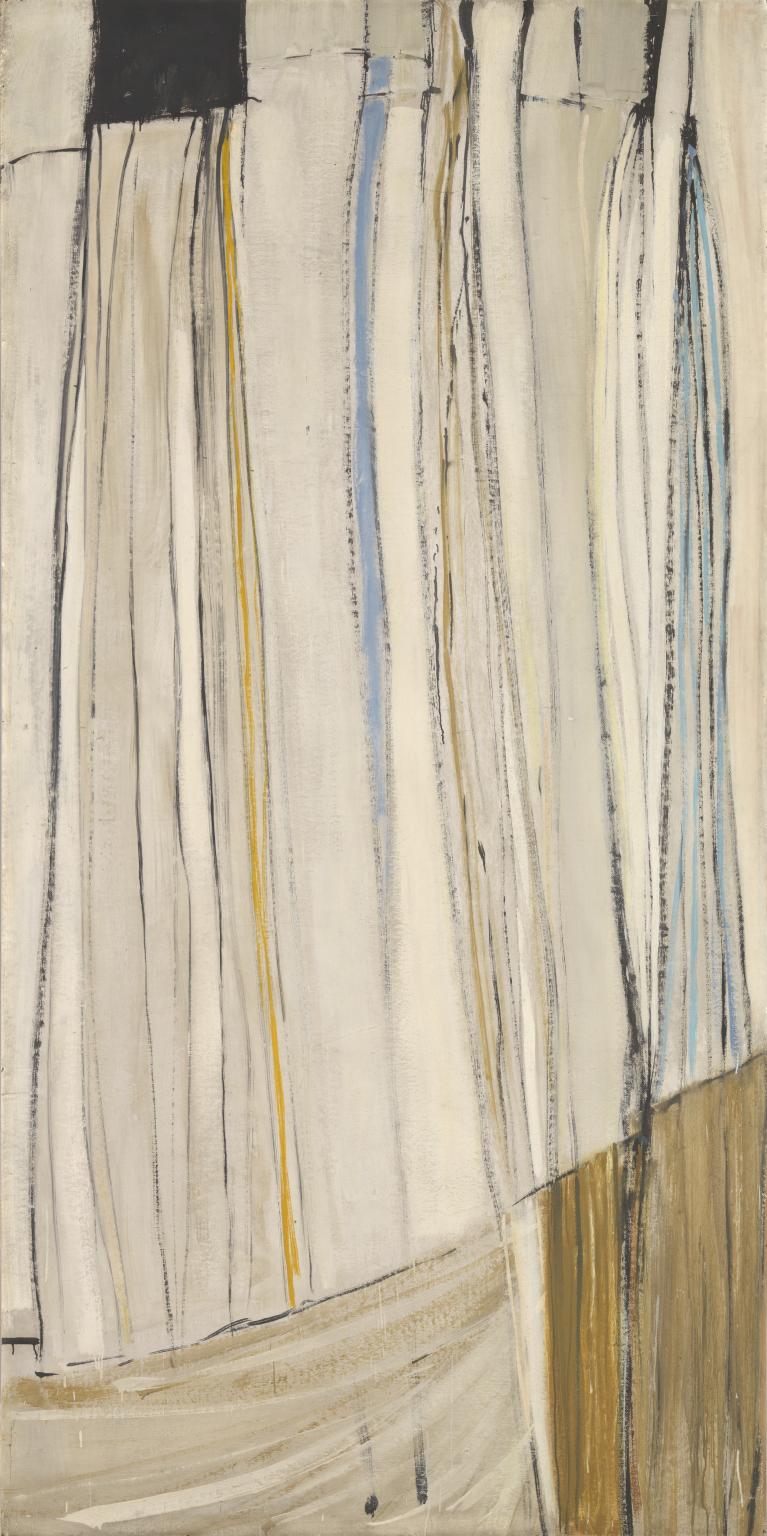
Sir Terry Frost, Winter 1956, Yorkshire 1956
Frost's move from St Ives to Leeds in Yorkshire introduced him to a new landscape. In the Yorkshire Dales he felt like a tiny presence in a huge expanse of space.
He related this unusually long, thin work to a particular experience: tobogganing with friends down a steep hill in Leeds, quite out of control. He said the black form at the top left derived from a Russian hat worn by his friend; the long sweep of the lines evokes his experience of careering down the hill.
Gallery label, September 2004
2/19
artworks in Modern Landscapes
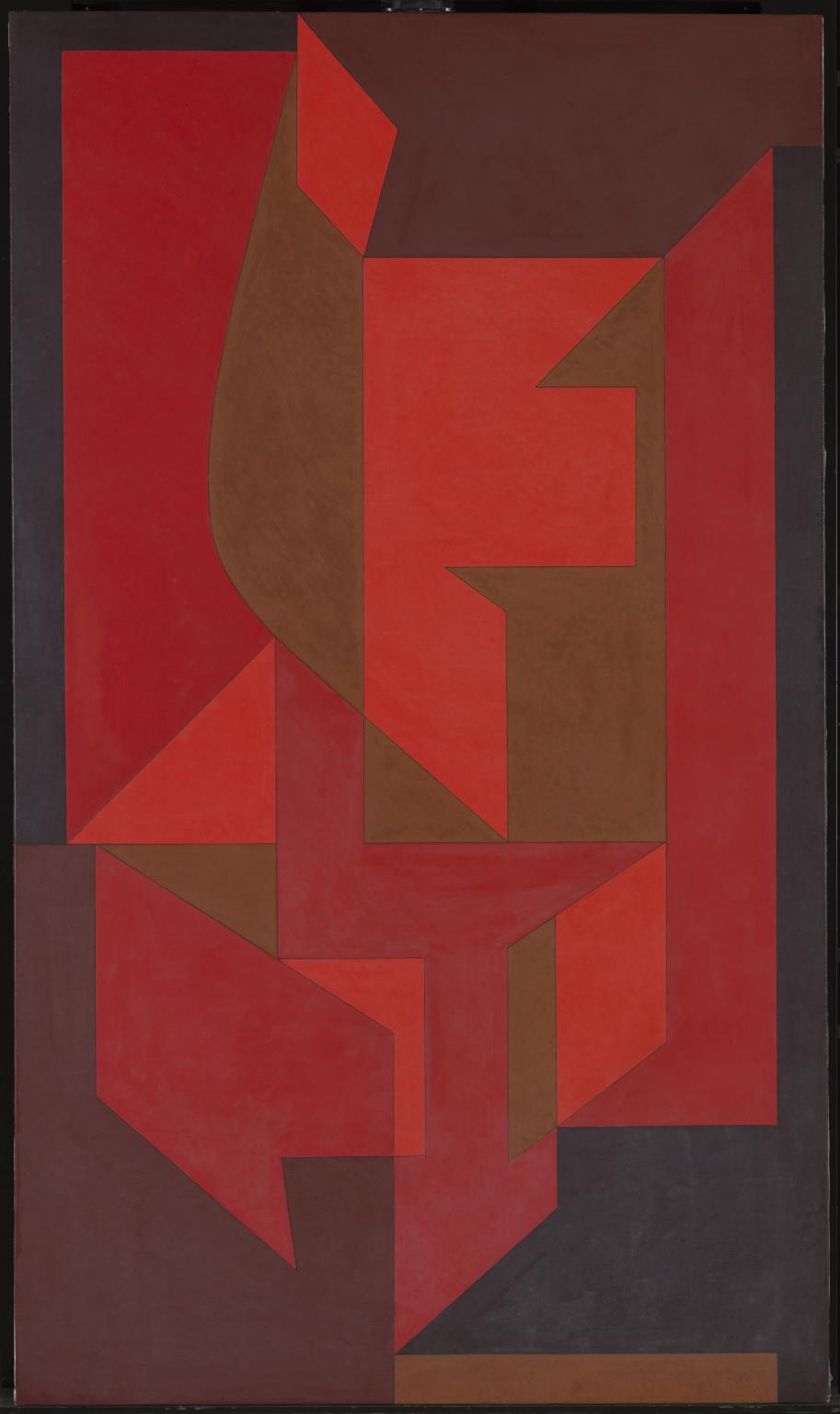
Victor Vasarely, Nives II 1949–58
3/19
artworks in Modern Landscapes
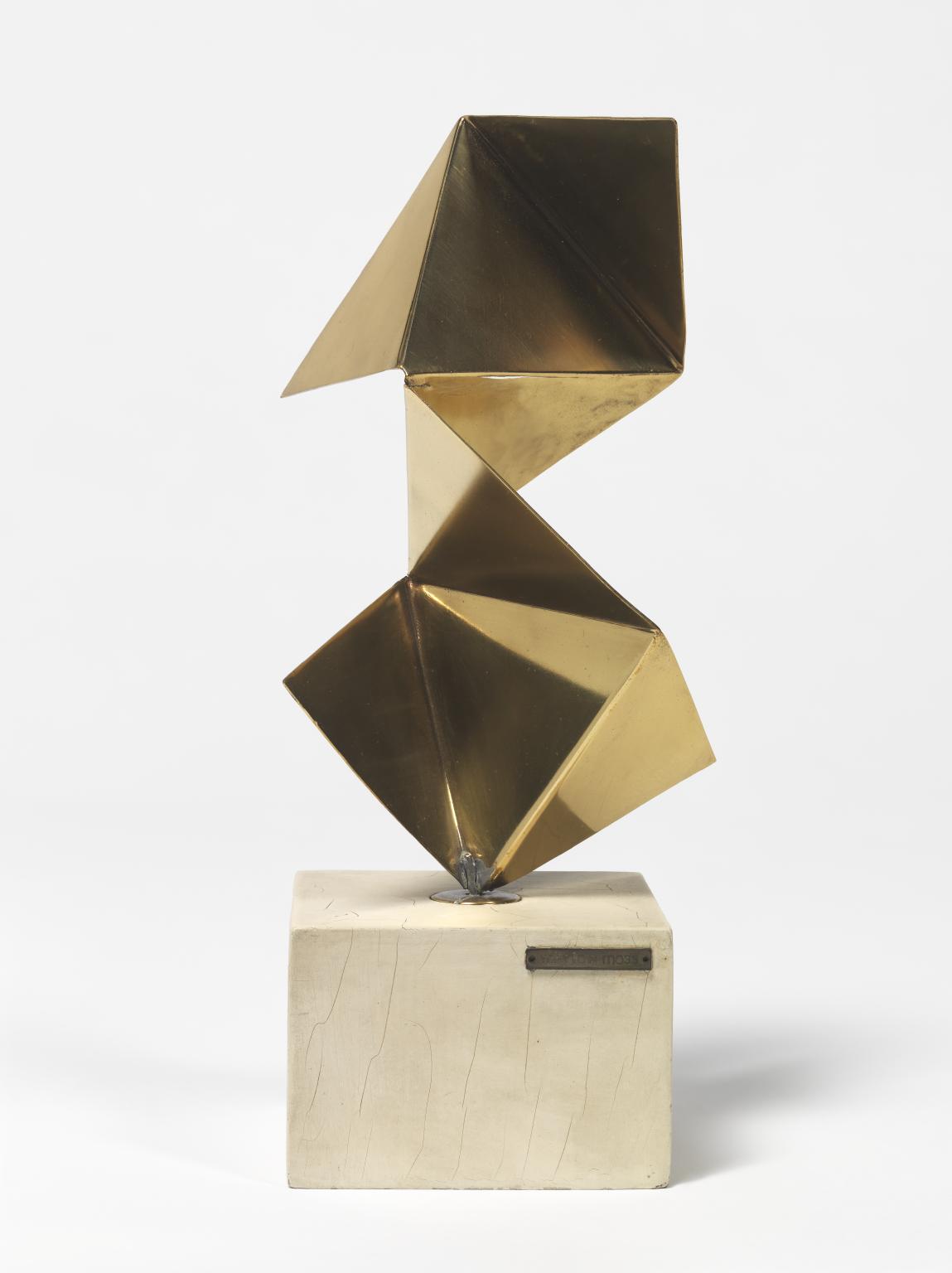
Marlow Moss, Untitled c.1950
This is one of three sculptures by Marlow Moss in which sheets of metal have been folded to create a pattern based on the structure and planes of a tetrahedron. The location of the other two is not known, but one of them is identified in a black and white archival photograph held in Tate Archives, which has an inscription by Moss on the reverse giving the title as Construction Based on a Tetrahedron and the date 1950. This photograph shows a construction composed of the same pattern of repeated tetrahedron planes as seen in Untitled c.1950, but extended so that it is formed of approximately five times as many elements. Each of the sculptures is fixed to a narrow cuboid base.The structure of this sculpture is characteristic of Moss’s three-dimensional work, which involved the exploration of concepts of geometrical mathematics. Moss is known to have read the philosophy of mathematician Matila Ghyka, whose ideas were founded upon the Pythagorean concept that the universe is formed entirely from principles of geometry. Since the late 1920s Moss had been familiar with the work and theories of the pioneering abstract artist Piet Mondrian (1872–1944), and is known to have met him in Paris in 1929.Moss attended the Slade School of Fine Art in London between 1917 and 1919. Moss’s life during the 1920s was characterised by movements between London and Cornwall. After a four-year period in Cornwall, in 1923 Moss returned to London. Moss’s name then changed from Marjorie to Marlow. A few years later, Moss was again in Cornwall, studying at Penzance Art School. In London from 1926, Moss had an exhibition with the London Group in 1927. That year Moss also moved to Paris, and attended the Académie Moderne and met Netty Nijhoff-Wind, who previously owned this sculpture. Part of a relatively varied community of artists associated with the Paris-based group Abstraction-Création in the mid-1930s, Moss here encountered the ideas and works of Swiss and French constructivists Max Bill (1908–1994) and Jean Gorin (1899–1981).During the Second World War Moss stayed with Nijhoff in the Netherlands, before fleeing for London in 1940, leaving a lot of work behind. Upon returning to England, Moss again travelled to Cornwall, and settled in Lamorna, south-west of Penzance. It is here that Moss began to make metal constructions such as a polished copper column of c.1944, partly inspired by having attended a course in architecture at Penzance during the war. Although Moss continued to make regular trips to Paris after the end of the war and exhibited in international groupings such as the Salon des Réalités Nouvelles, Lamorna remained Moss’s permanent residence until her death in 1958.The sculpture Untitled c.1950 is characteristic of Moss’s sculptural works of the 1950s, many of which were conceived as explorations in geometrical relationships. In material and form is it reminiscent of the totemic but restrained resonance of works by the modernist sculptor Constantin Brancusi (1876–1957) and the abstract sculpting of geometrical planes in the early work of Naum Gabo (1890–1977). In its basis upon non-representational geometry it is also closely connected to the tenets of post-war constructivism in Britain and further afield. Within the artist’s output of this period, these tetrahedron constructions are comparable to other metal constructions formed of geometric elements, such as the steel Spatial Construction 1949 (Nijhoff/Oosthoek Collection, Zurich), and later forms of polished brass sheets, including Concentric Circles Projected in Space 1953 (whereabouts unknown). Over the following years Moss’s sculptures took on added complexity regarding the range of materials and forms assembled together, as demonstrated by Balanced Forms in Gunmetal on Cornish Granite 1956–7 (Tate T01114). Further reading Florette Dijkstra, Marlow Moss: Constructivist the Reconstruction Project, translated Annie Wright, Den Bosch, Netherlands 1995.Lucy Howarth, Marlow Moss (1889–1958), Ph.D. thesis, University of Plymouth 2008, series illustrated p.129.Sabine Schaschl (ed.), A Forgotten Maverick: Marlow Moss, exhibition catalogue, Museum Haus Konstruktiv, Zurich 2017, illustrated p.83.Rachel Rose SmithAugust 2018Revised 2023
4/19
artworks in Modern Landscapes
Donna Conlon, Coexistence 2003
5/19
artworks in Modern Landscapes
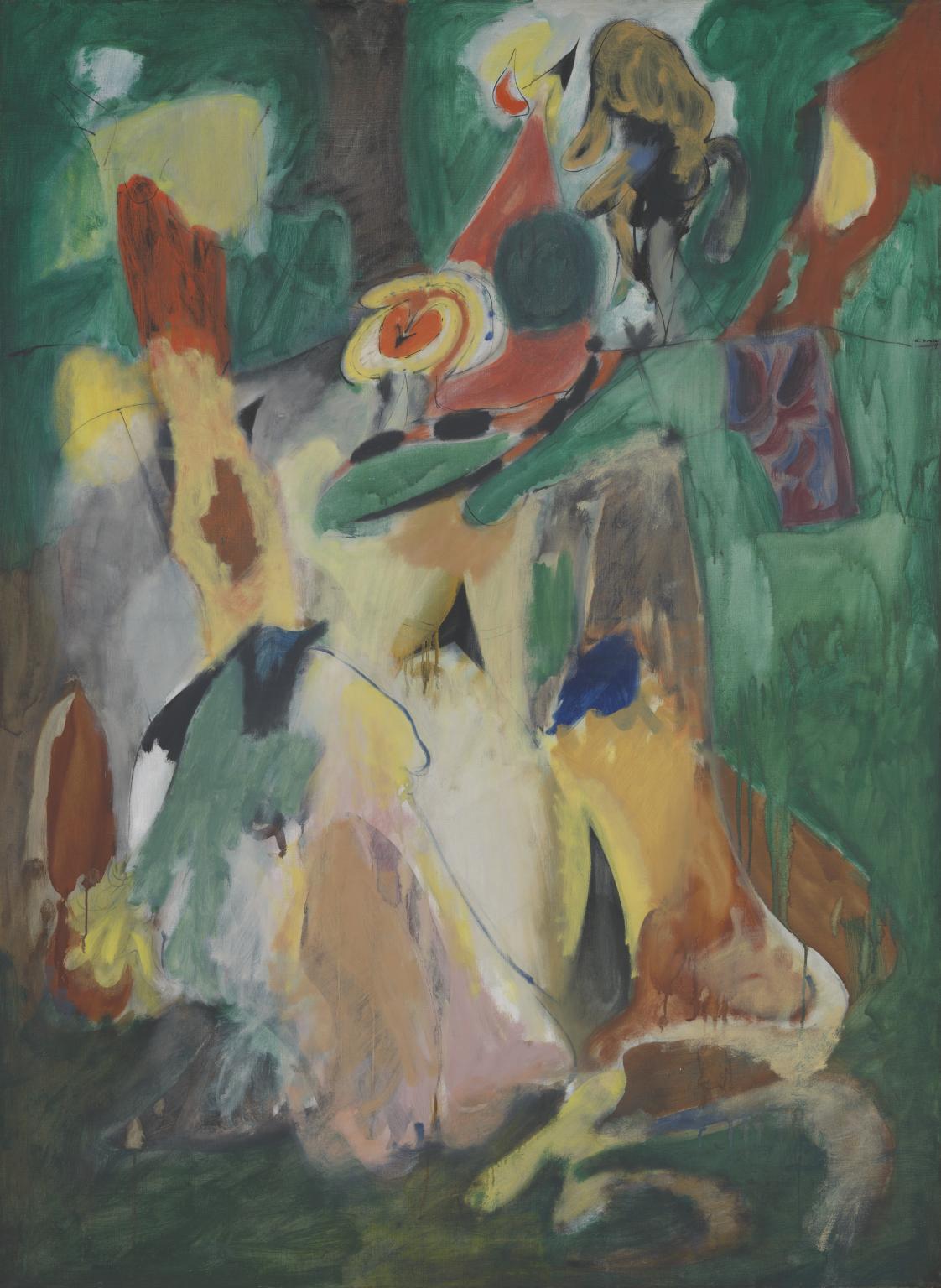
Arshile Gorky, Waterfall 1943
Gorky was born in Armenia, but was forced to flee Turkish persecution, and in 1920 settled in the USA. His early work was strongly influenced by Pablo Picasso and the European Surrealists. In the summer of 1942, Gorky spent three weeks in Connecticut making drawings from nature. He went on to produce a series of paintings that refer to natural forms. In this painting, amorphous shapes and drips of liquid paint suggest the fluidity of the waterfall.
Gallery label, August 2004
6/19
artworks in Modern Landscapes
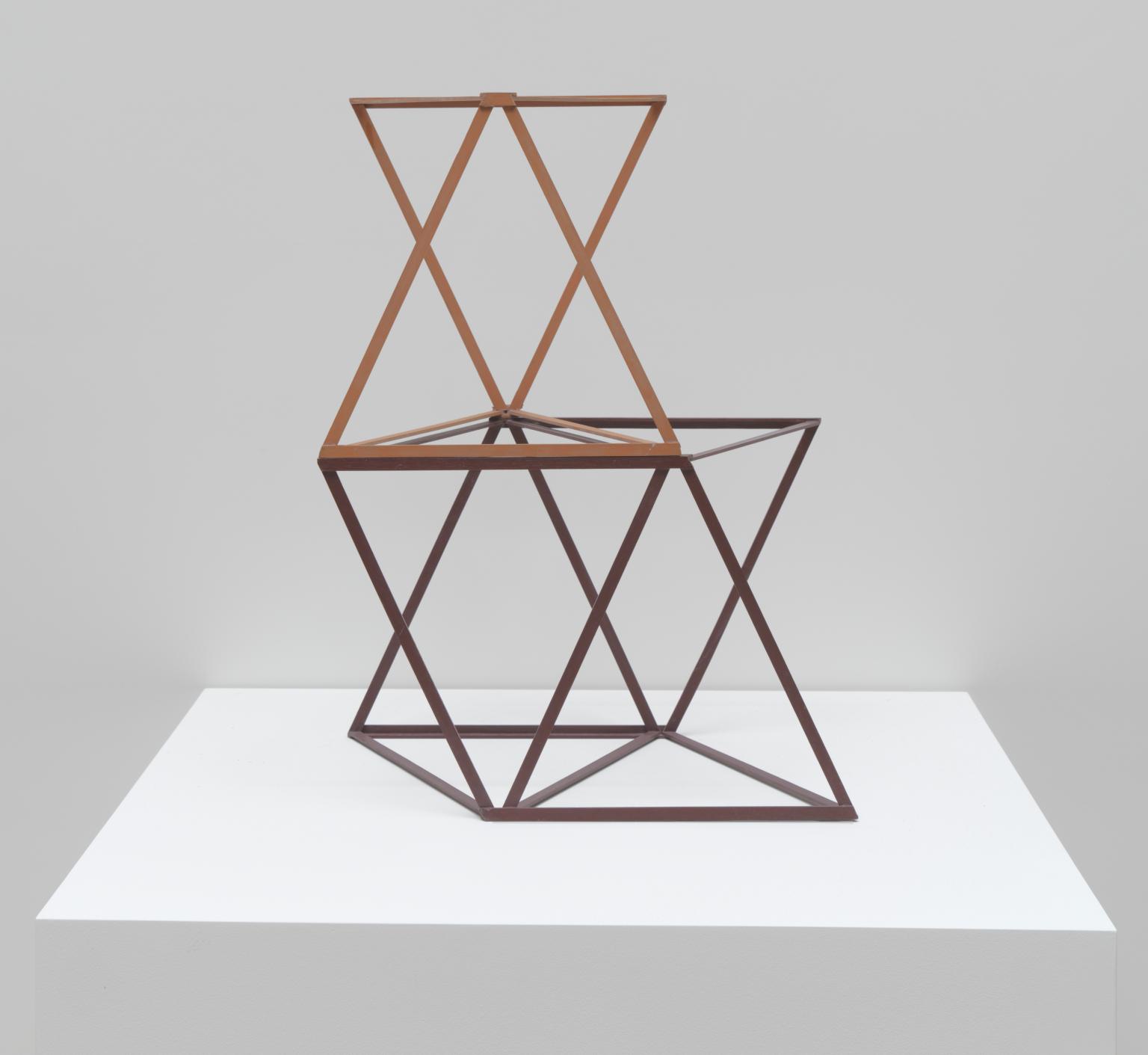
Rasheed Araeen, Lovers 1968
Araeen trained as a civil engineer, and his sculptures are constructed using geometric forms. Lovers combines two structures, each of which consists of a series of triangles that have been rotated and orientated in different ways. The work can be shown in two different configurations: either with the two parts next to each other, or on top of each other. This introduction of alternative possibilities challenges the idea of the artwork as a fixed object conceived by a single individual.
Gallery label, October 2016
7/19
artworks in Modern Landscapes
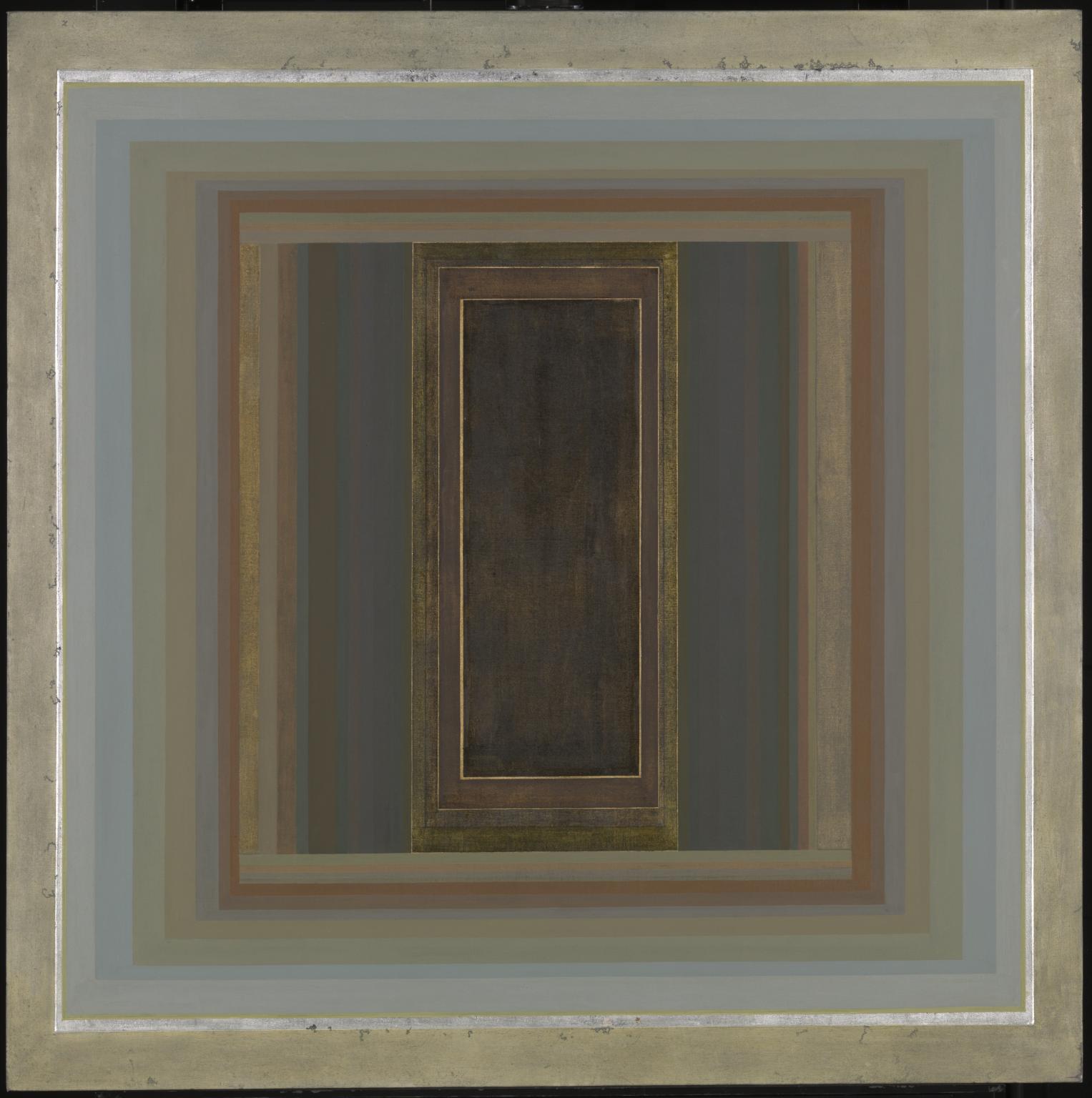
Paul Feiler, Janicon LXII 2002
Janicon LXII 2002 is a square abstract painting on canvas. This canvas has been stretched over a built-up stretcher that, with the addition of silver leaf around the edges of the canvas, provides an illusion of a separate frame for the painting. This is however not the case, and the silver leaf border sets up the sharply recessive space that is described by succeeding horizontal and vertical bands of pale blues, greys, greens and browns. The back board of this illusionistic space is a field of similarly coloured vertical bands, in the centre of which is an upright oblong, bounded off-centre in gold leaf. The title brings together references of the double Janus head that looks both back in time and towards the future, with the gold and silver leaf of Byzantine religious icons. Despite the use of geometry and pale colour, the paintings in Feiler’s extensive Janicon series, of which this is a part, are built up of many layers of colour over a long period of time.
8/19
artworks in Modern Landscapes
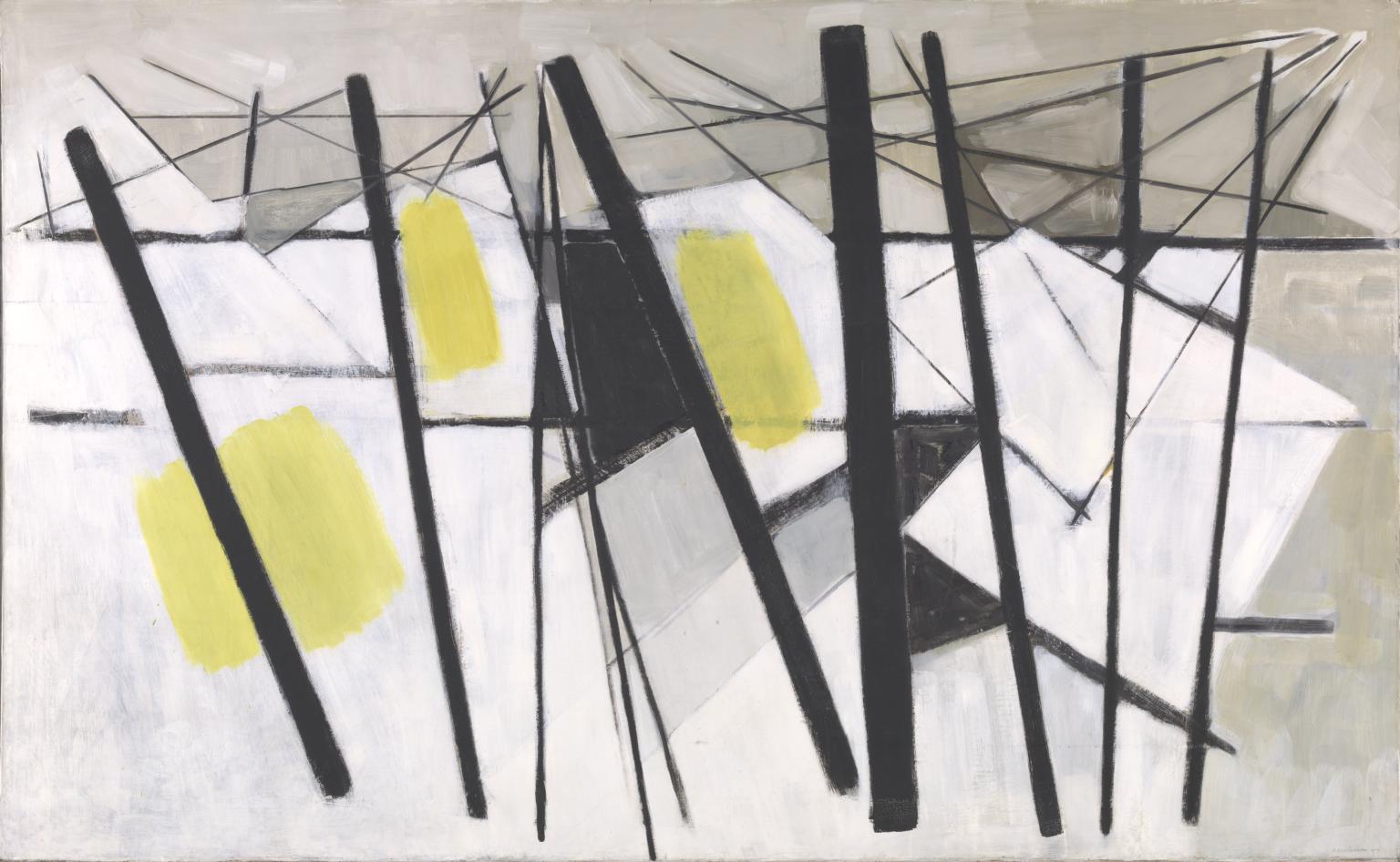
Wilhelmina Barns-Graham, White, Black and Yellow (Composition February) 1957
White, Black and Yellow (Composition February) 1957 is a painting in a landscape format that uses abstract elements of line and colour to describe a view onto a three-dimensional space. A series of densely-painted black lines or shafts stand across the painting at acute angles. Set behind these prominent black structures are thinner black lines: some of these lie perpendicular to the vertical black lines like a horizon-line or a scaffold; others are angled so they seem to describe perspectival lines leading from the foreground towards a more distant space. Within this structure are placed three yellow lozenges or patches of colour which punctuate and describe the middle ground. Each is physically close to a vertical black line of corresponding thickness, and their variation in size enhances the suggestion of depth behind the picture plane. The largest is closest to the lower edge of the painting while the two smaller ones, placed higher up, seem to be further behind. The suggestion of depth is also achieved by the overpainting of some black lines in the middle ground with white paint. This wider field of white and grey seems to describe a low-lying ground or floor (upon which some darker sections might be read as shadows) and a visual field saturated with light.
9/19
artworks in Modern Landscapes
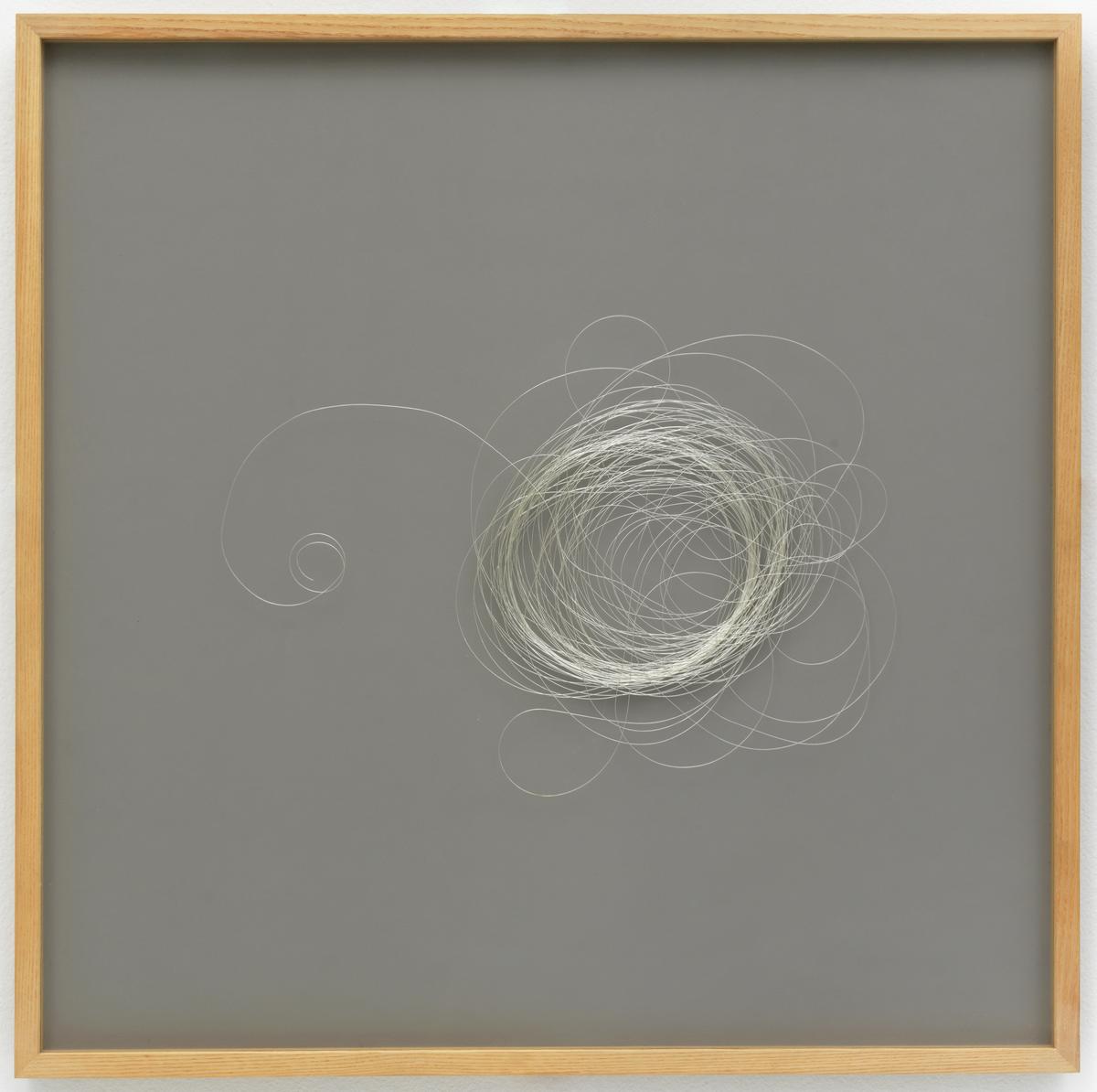
Cornelia Parker CBE RA, Measuring Niagara with a Teaspoon 1997
Created by the British artist Cornelia Parker in 1997, Measuring Niagara with a Teaspoon is a coiled length of silver wire mounted on a square of dark grey card that is set inside a glazed, pale wooden frame. The silver that makes up the piece of wire previously took the form of a Georgian teaspoon which, as the artist explained in a 2003 interview, has been melted and ‘“drawn” to the height of Niagara Falls’ – a set of three waterfalls situated on the border between the United States and Canada (Parker in Lisa Tickner, ‘A Strange Alchemy: Cornelia Parker’, Art History, vol.26, no.3, June 2003, p.385). While the precise length of the piece of wire is unknown, in 2013 the artist stated that it measures ‘approximately 187 feet’ (Cornelia Parker, ‘Works’, in Blazwick 2013, p.123). It is coiled into a thick ring that occupies a small portion of the grey card near to the centre of the frame and has numerous strands curving outwards around its edges. The frame is made from untreated ash wood and has mitred corners, and its reverse side comprises a sheet of fibreboard secured with masking tape.
10/19
artworks in Modern Landscapes
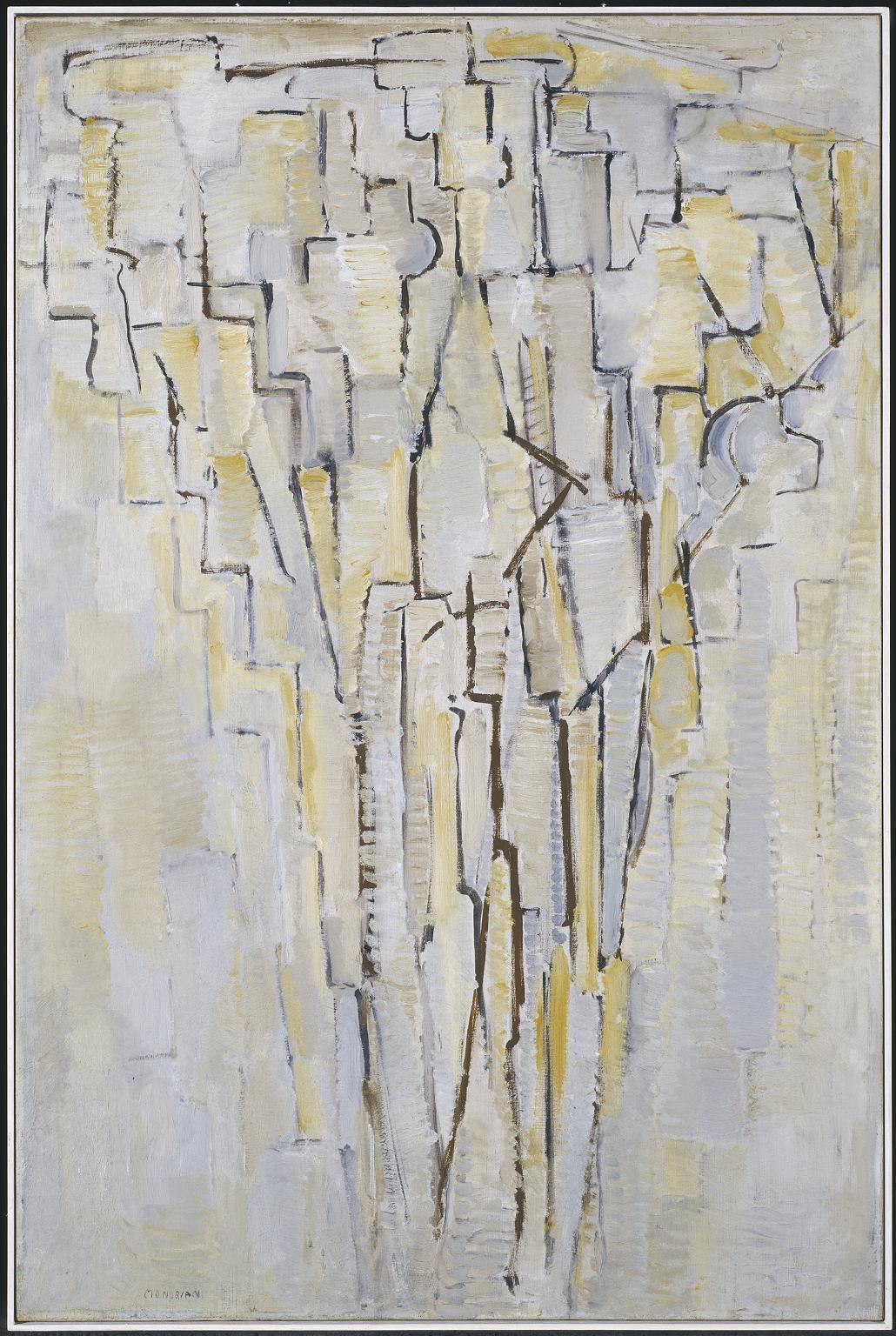
Piet Mondrian, The Tree A c.1913
Mondrian’s fascination with trees developed out of his earlier landscape painting. This is one of his last paintings of trees and is based on realistic sketches made in the Netherlands. After settling in Paris and absorbing the influence of Cubism, Mondrian reworked the image almost to abstraction. The trunk and branches are condensed to a network of verticals and horizontals. He acknowledged the inspiration of nature but added, ‘I want to come as close as possible to the truth, and abstract everything from that until I reach the foundation of things’.
Gallery label, April 2013
11/19
artworks in Modern Landscapes
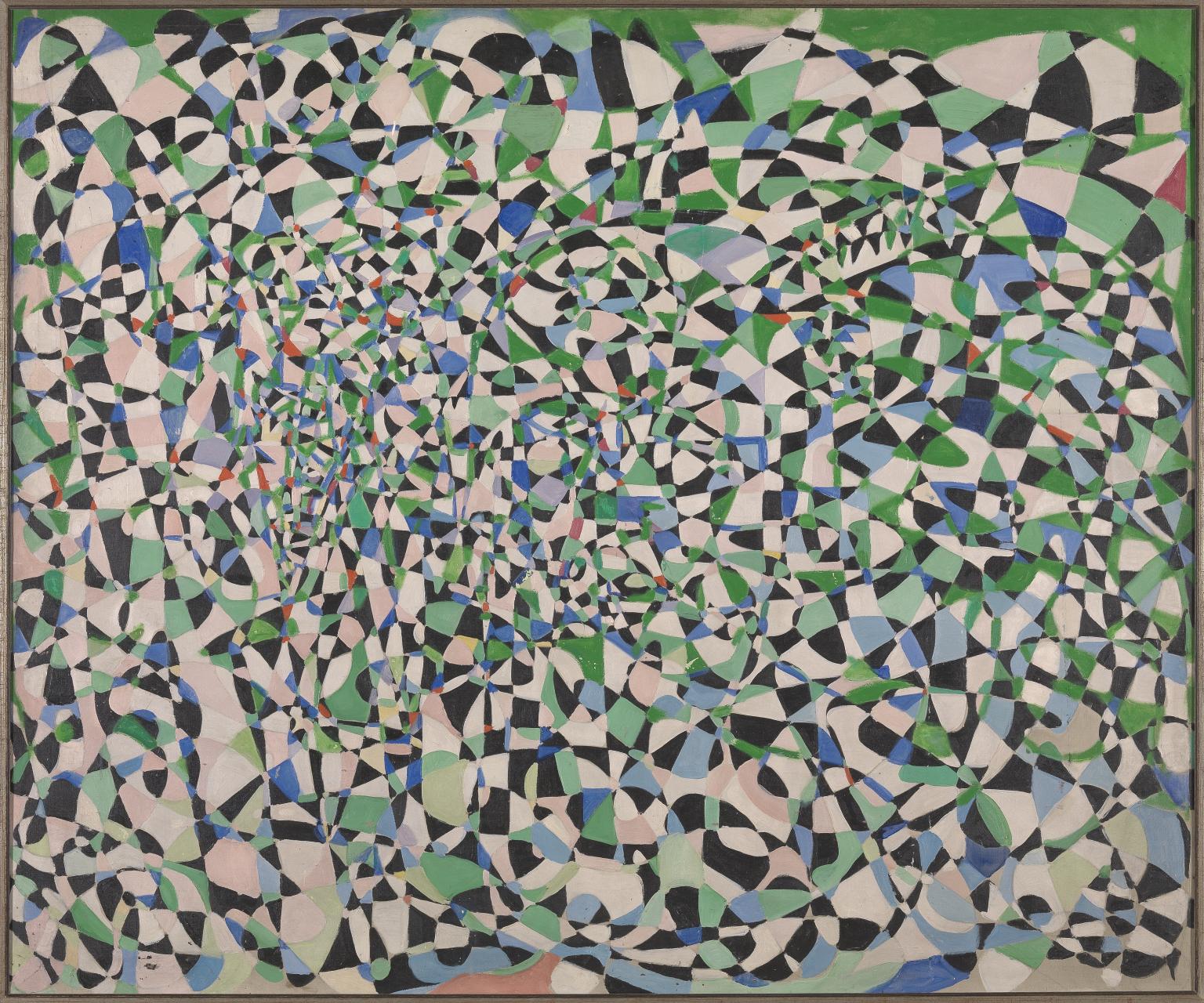
Fahrelnissa Zeid, Untitled c.1950s
Fahrelnissa Zeid used swirling, crossing lines to paint this abstract artwork. After drawing the lines in pencil, she filled in the shapes made between them with black, green, blue and pink. The result is a complex, kaleidoscopic effect. Zeid made the painting when she was living in London in the 1950s. In 1949 she had taken her first transatlantic flight and was captivated by the abstracted perspective of aerial views. She later translated their scale and feeling into the whirling shapes that appear in this painting. A divisionist effect is achieved, whereby individual patches of colour are built up to create an overall composition.
Gallery label, November 2021
12/19
artworks in Modern Landscapes
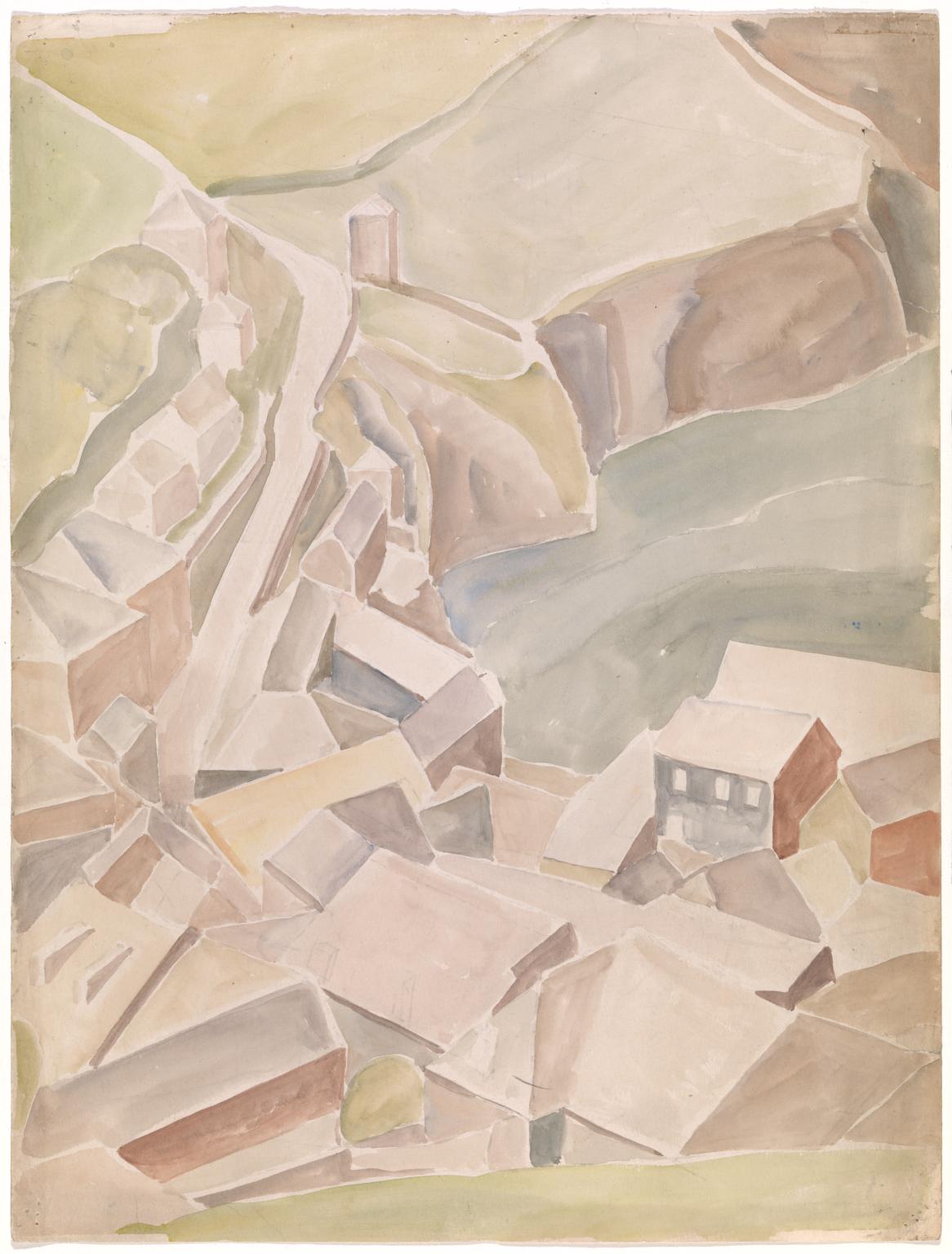
Helen Saunders, View of Port Isaac 1930s
View of Port Isaac 1930s is a view of the harbour painted from the hillside above the village of Port Isaac on the north coast of Cornwall. Saunders often spent holidays in Cornwall as a child and she visited Port Isaac many times in the late 1920s and 1930s. In this work she simplified the roofs of the houses to a series of geometric shapes which cluster at the base of the composition, while the coastline beyond and a road winding up to the top left are tilted upwards to create a vertical arrangement of forms. The art historian Brigid Peppin has described how, in Saunders’ watercolours of this period, she used ‘a tilted and flattened perspective to produce a topographically ambiguous landscape where uncertain spatial relationships enhance the formal design without compromising a sense of place’ (in Ashmolean Museum 1996, p.18). She also notes how the narrow unpainted strips which Saunders often used in this period to outline the areas of wash reverse ‘graphic expectations of dark boundaries [and] served to dislocate illusion’ (ibid.). Peppin argues that these ‘modernist’ affirmations of the picture surface show Saunders’s continuing emphasis on contemporary developments in her later figurative work.
13/19
artworks in Modern Landscapes
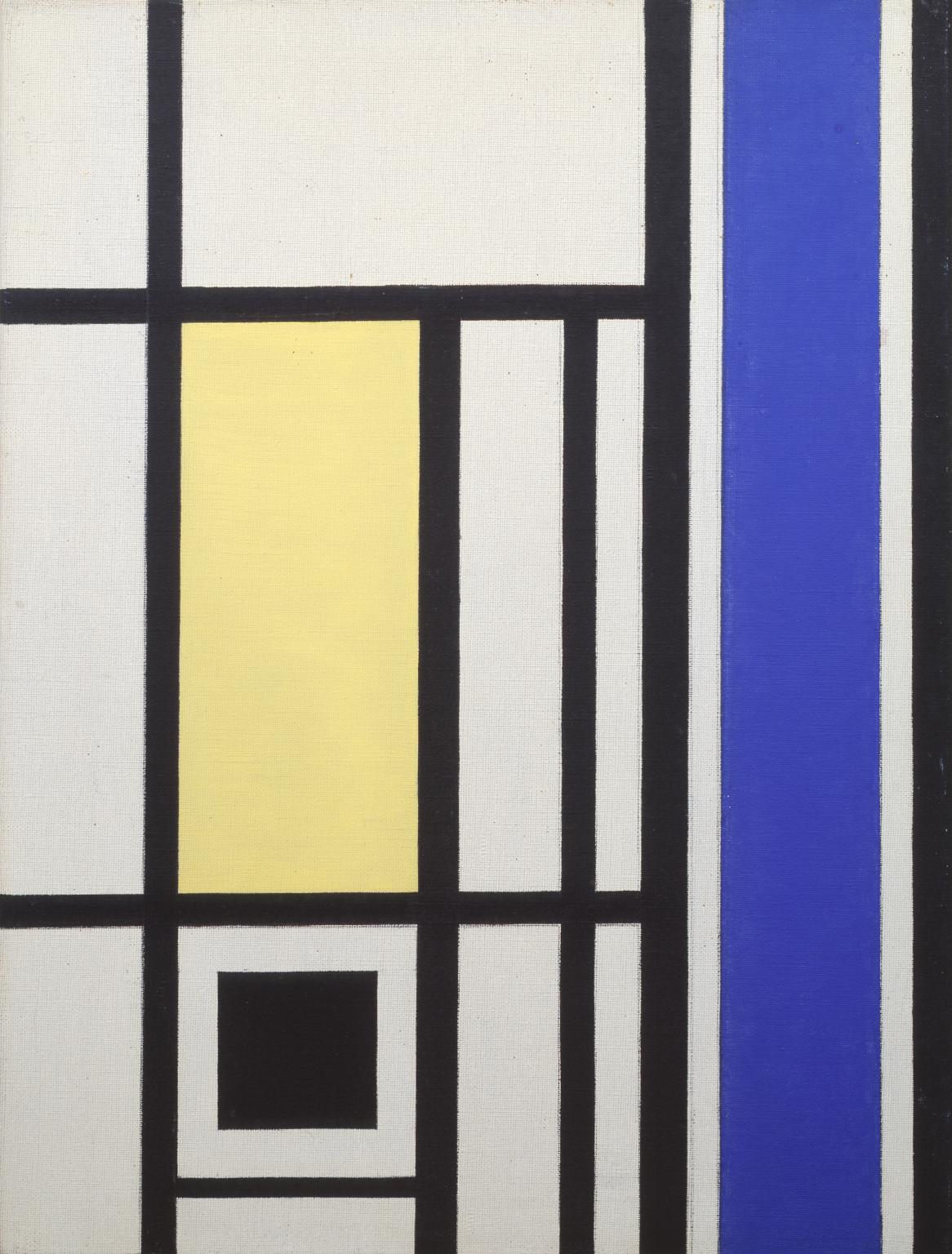
Marlow Moss, Untitled (White, Black, Blue and Yellow) c.1954
14/19
artworks in Modern Landscapes
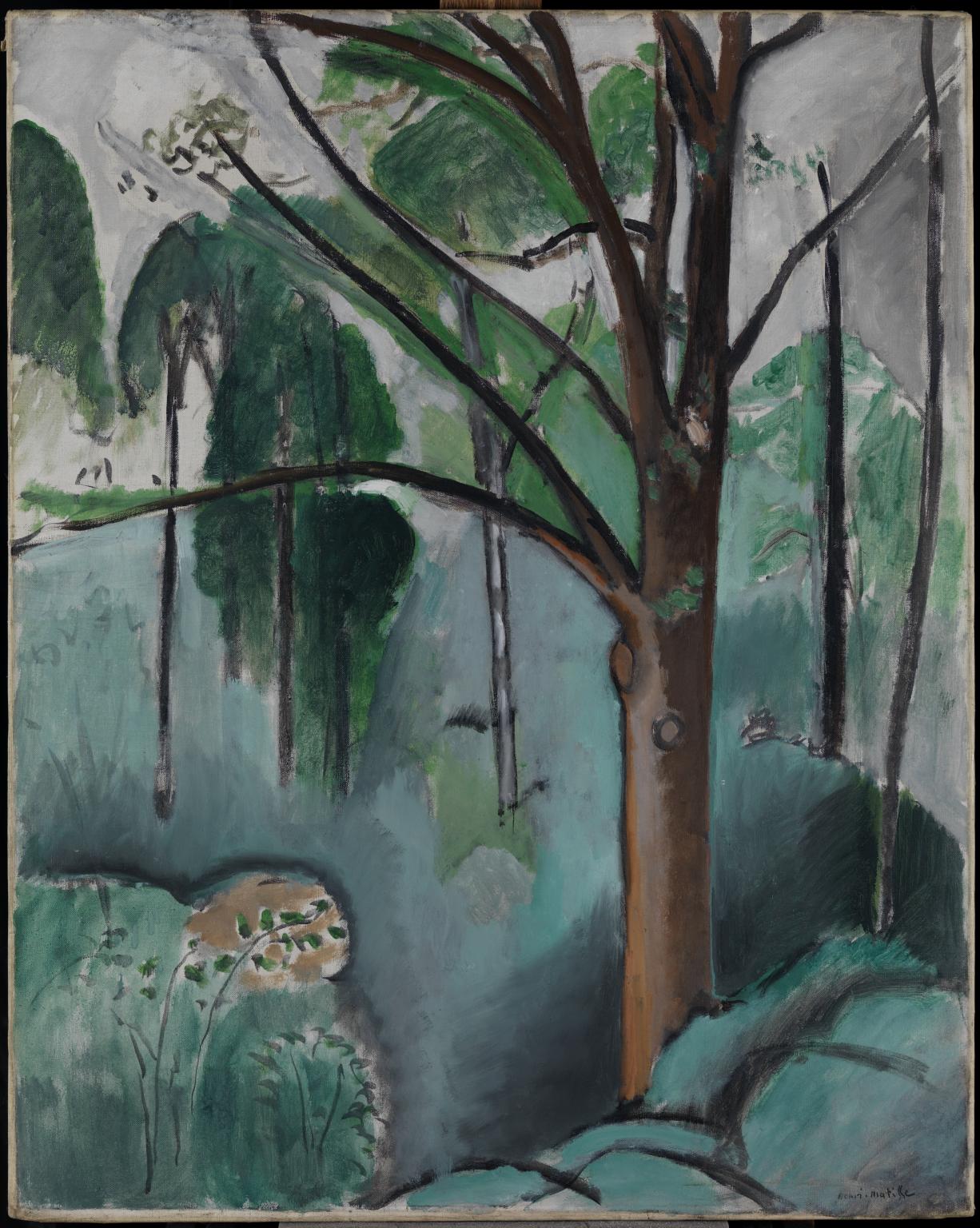
Henri Matisse, Trivaux Pond 1916 or 1917
The purchase of a car in 1917 allowed Matisse to take all his painting equipment into the woods. He made several works at Trivaux Pond, in the landscaped park of the Bois de Meudon on the outskirts of Paris. Here, the verticals of the trees establish a strong rhythm. Matisse treats the surface of the pond loosely, simplifying the forms and merging reflections with their surroundings. Although within the immediate environs of the city, Matisse imbued the park with an imagined ruralism.
Gallery label, August 2004
15/19
artworks in Modern Landscapes
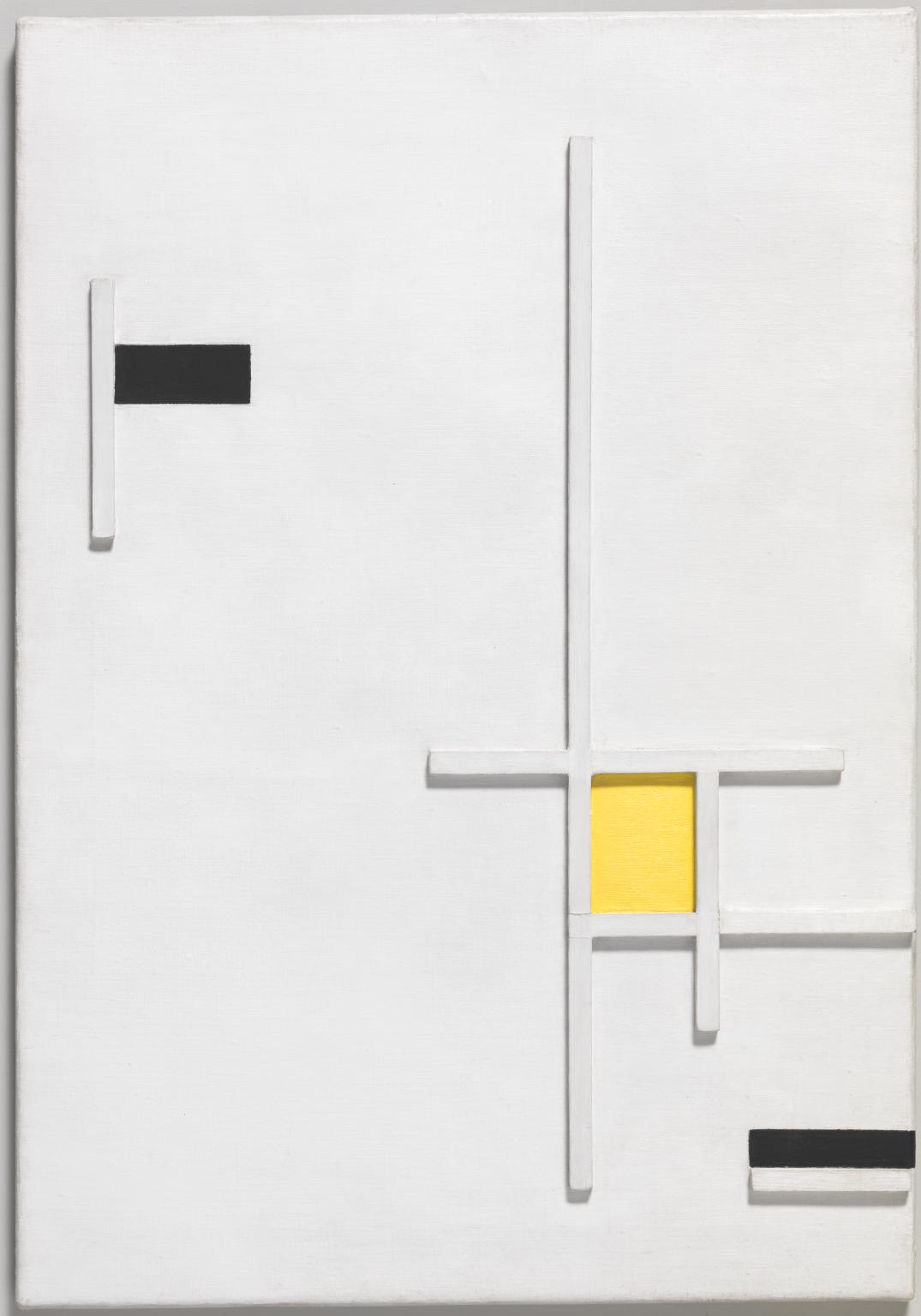
Marlow Moss, Composition in Yellow, Black and White 1949
Moss wrote, ‘I am no painter, I don’t see form, I only see space, movement and light’. Moss’s three-dimensional works, which Moss first made in white, relate to the structural grids popular in the Dutch art movement ‘De Stijl’ and the paintings of abstract artist Piet Mondrian. Here, two small black horizontal planes counterbalance a bright yellow section and a network of white lines that stand out from the canvas. Together these white, yellow and black elements interact to create a sense of movement and light.
Gallery label, August 2023
16/19
artworks in Modern Landscapes
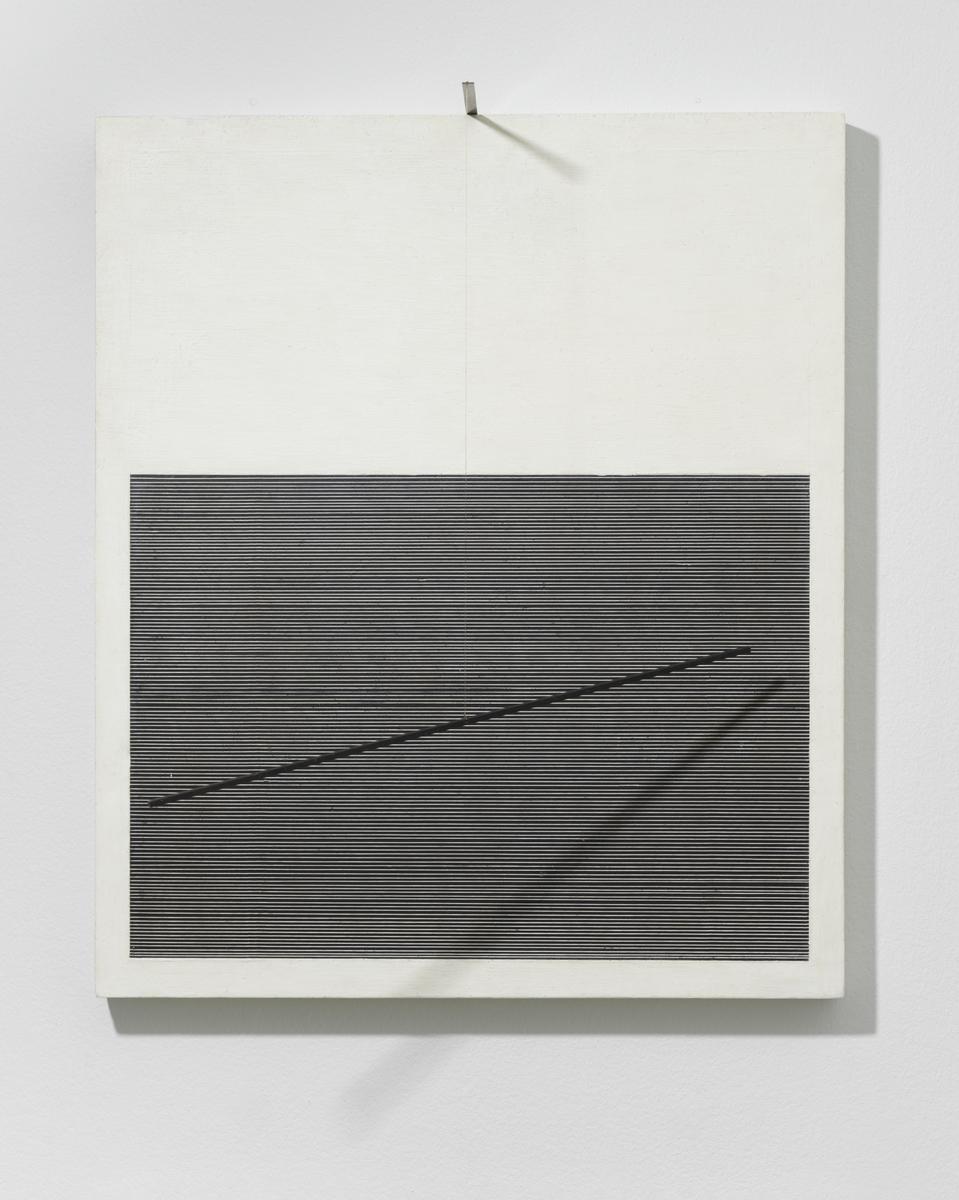
Jesus Rafael Soto, Horizontal Movement 1963
As the spectator passes this work, an optical effect causes the background of black and white lines to vibrate and flicker. Soto described Horizontal Movement as ‘one of the first truly mobile works that I had made’, referring to the addition of an iron rod that hangs in front of the lines. As in all his works the background lines are drawn by hand.
Gallery label, September 2004
17/19
artworks in Modern Landscapes
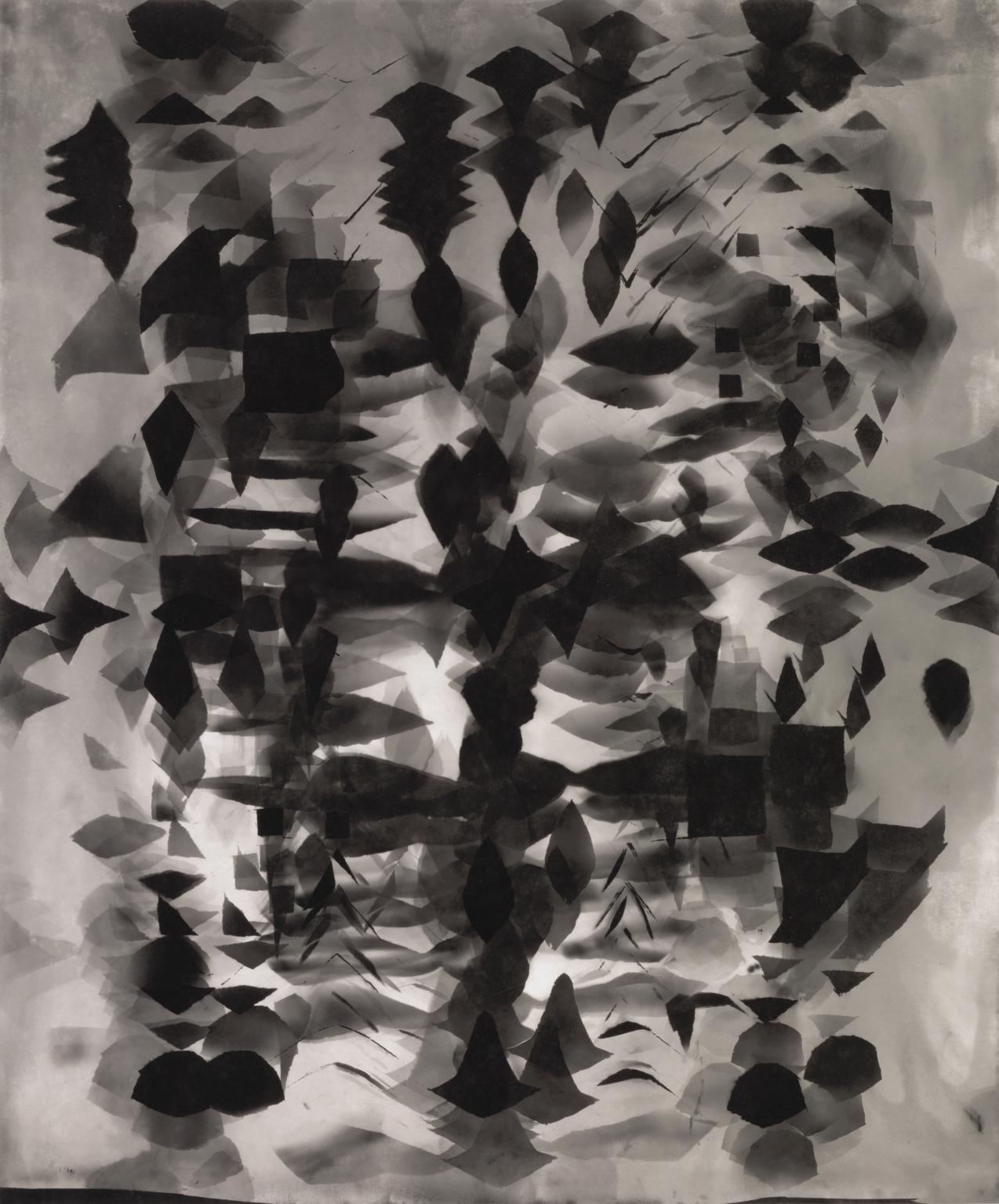
Nalini Malani, Untitled I 1970/2017
Untitled I is one of three works in Tate’s collection from a series of black and white photograms by the Indian artist Nalini Malani (see also Untitled II [Tate P82089] and Untitled III [Tate P82090]). The three images all date from 1970 and are visually similar in nature: monochromatic geometric studies in light and form. Originally produced as photograms, exposing light-sensitive paper to light without the use of a camera, these works now exist as photographic prints in an edition of ten. Tate’s copies were printed in 2017 and are number four in the edition. The photograms were first exhibited at the Pundole Art Gallery, Bombay in 1970, printed to a similar scale as the later edition.
18/19
artworks in Modern Landscapes
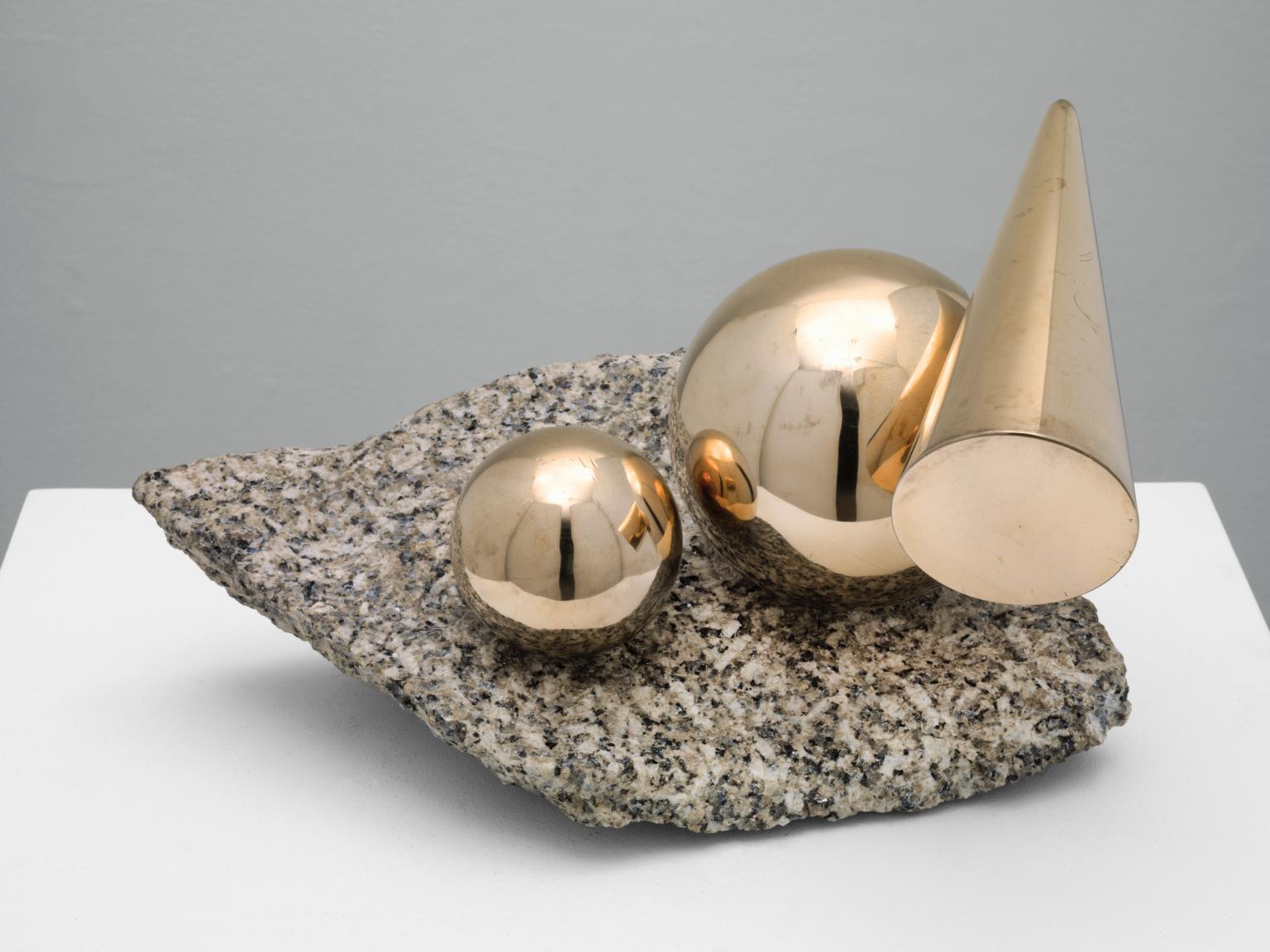
Marlow Moss, Balanced Forms in Gunmetal on Cornish Granite 1956–7
Marlow Moss, born Marjorie Moss, studied briefly at the Slade School and then at Penzance Art School in Cornwall. In 1927 after a short but crucial visit to Paris, in which Moss was overwhelmed by the work of the painter Piet Mondrian, Moss broke off connections with England and went to live and work in Paris. Moss made contact with Mondrian then and subsequently became a pupil of Léger and Ozenfant. With the advent of the Second World War, Moss fled from France and returned to Cornwall. There, Moss made abstract paintings in pure colours and some geometric sculptural compositions, of which this is a rare example.
Gallery label, August 2023
19/19
artworks in Modern Landscapes
Art in this room




Sorry, no image available














You've viewed 6/19 artworks
You've viewed 19/19 artworks
